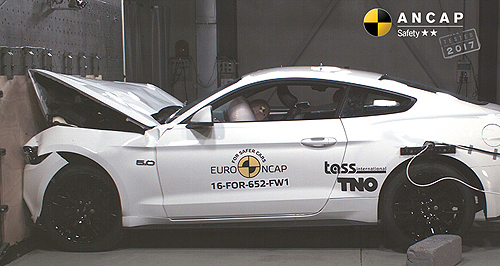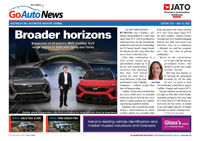Make / Model Search
News - Ford - MustangANCAP rejects full re-test of updated Ford MustangStang face: The updated Ford Mustang gets a small tweak in styling that includes all-LED headlights, a revised grille and updated front and rear bumper. Test re-evaluation will move the Ford Mustang from two stars to three from mid-year14 May 2018 THE Australasian New Car Assessment Program (ANCAP) will not re-test the Ford Mustang following its shock two-star safety result, despite an update to airbag deployment and active safety features that crippled its score.
Instead, the vehicle safety watchdog will revise the Ford sportscar’s score to three stars in light of the updates.
Sales of the Ford Mustang have remained unaffected by the two-star ANCAP result handed down in December 2015, and it continues to be Australia’s top-selling sportscar as it heads towards a mid-year switch to a facelifted model.
The original test score raised questions not only directed towards Ford, however, but also ANCAP owing to a testing procedure that had changed significantly compared with before.
While 2+2 coupes would now be tested for back-seat performance, despite the Toyota 86 among others having not been tested with rear child seats, the top overall score could also be no higher than the lowest score of four criteria (occupant protection front, rear, pedestrian and active safety).
Even with a front airbag that allowed front occupants to nudge the dashboard or steering wheel, the Mustang received a 72 per cent score for front safety but just 32 per cent for rear child protection. The two-star rating was derived only from the active safety score of just 16 per cent.
The facelifted Ford will gain equipment such as a blind-spot monitor, lane-keep assistance and autonomous emergency braking (AEB) already available in Europe, which raised its active safety scorecard from 16 per cent to 61 per cent and also its pedestrian protection rating from 64 per cent to 78 per cent.
Ford Australia communications manager Martin Günsberg confirmed to GoAuto that, “we have updated the restraint system in the 2018 MY (model year) Mustang, which will prevent head contact in the Euro NCAP frontal offset crash scenario”.
Despite the claimed improvements, however, ANCAP chief executive James Goodwin insisted there was no need to crash a facelifted Mustang as on-paper it could update its scorecard from this data.
“We’ve already had some discussions with Ford on the update to the Mustang, (and) we look forward to their submission to update that,” he told GoAuto at an event at the federal government-funded Crashlab facility in Sydney last week.
“They won’t need to physically crash test it. We can do re-tests. But it would have to be some significant design changes to a vehicle to prompt a (full) re-test.
“We will take a submission from them, and we will be able to update the rating according to that. So we are expecting it would be three stars.”
Mr Goodwin admitted that had the Mustang been designed as a two-seat sportscar, it would have achieved a much higher rating on that basis alone.
“An interesting hypothetical is, what if it (Mustang) was only a two-seater vehicle? It probably would have gone up two stars,” he said.
“But because they did put seats in the rear, it needs to be tested as though those seats are occupied by anyone that can sit in them. So what we say, now with the new protocol, if you put seats in the rear, we will assume that they are suitable for anybody.”
Asked why this had changed when every other 2+2 coupe was not tested for child seat performance prior to the Mustang crash test, including the similarly popular Toyota 86 which retained its five-star ANCAP rating, Mr Goodwin replied: “I think that’s probably one of those examples where we need to look at the age of the rating.
“Vehicle brands do make updates to cars all the time. What we’re really urging is that when you put a new grille on it, when you put a new sound system in, you also need to consider the safety elements.”
In 2017, the Ford Mustang recorded 9165 sales compared with 2405 for the Toyota 86/Subaru BRZ twins.
In the priciest sportscar category, 411 sales for the Porsche 911 outsold its nearest rival by two-to-one, but despite costing at least four times as much as a Mustang, the German 2+2 lacks AEB and has not been tested.
Although the 911 – with two small rear seats and no AEB – would have the potential for a two-star safety rating based on its active safety scorecard alone, Mr Goodwin indicated low-volume sportscars are otherwise not on the ANCAP hit-list for 2018, despite this seeming inconsistency.
Such an issue was not lost on Ford Australia’s Mr Günsberg: “The majority of coupes sold in Australia are low-volume vehicles and as such, remain untested or have gone through less rigorous protocols than what the Mustang was tested under at the time.
“It is important to know that (the pre-facelift Mustang) score is still a high score for the frontal-offset test and is higher than the frontal offset score achieved by many other vehicles which have a five-star Euro NCAP rating.”  Read more |
Click to shareFord articlesResearch Ford Mustang pricingMotor industry news |












Facebook Twitter Instagram